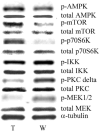Insulin-like growth factor I-mediated skeletal muscle hypertrophy is characterized by increased mTOR-p70S6K signaling without increased Akt phosphorylation
- PMID: 15921033
- PMCID: PMC3228637
- DOI: 10.2310/6650.2005.00309
Insulin-like growth factor I-mediated skeletal muscle hypertrophy is characterized by increased mTOR-p70S6K signaling without increased Akt phosphorylation
Abstract
Background: Insulin-like growth factor I (IGF-I) is an anabolic hormone that is known to induce skeletal muscle hypertrophy. However, the signaling pathways mediating IGF-I's hypertrophic effect in vivo are unknown.
Method: The phosphorylation of 46 proteins was investigated by Kinetworks proteomic analysis in the gastrocnemius muscle of transgenic mice overexpressing IGF-I myosin light chain/muscle specific IGF-I (MLC/mlgf-I) and wild-type littermates.
Results: In the hypertrophic muscle of MLC/mlgf-I mice, we observed increased phosphorylation of phosphoinositide-dependent protein kinase 1 (PDK1; 53% increase), the mammalian target of rapamycin (mTOR; 112% increase), and p70 S6 kinase (p70S6K) (254% increase) but no significant change in Akt phosphorylation (4% decrease). Furthermore, we found reduced phosphorylation of MAP kinase kinase 1 and 2 (MEK1/2) (60% decrease) and of mitogen-activated protein kinase kinases 3 and 6 (MKK3/6) (50% decrease) in muscle from transgenic mice, suggesting that the hypertrophic and mitogenic effects of IGF-I are mediated via distinct signaling pathways in skeletal muscle and that inhibition of the mitogen-activated protein (MAP) kinase pathway may be required for the IGF-I-induced hypertrophic effect. Single-fiber analysis revealed a trend toward a higher percentage of the fast twitch fibers (IIb and IIx) in the transgenic mice.
Conclusion: Persistent overexpression of IGF-I in mice skeletal muscle results in hypertrophy, which is likely mediated via the mTOR/p70S6K pathway, potentially via an Akt-independent signaling pathway.
Figures



References
-
- Florini JR, Ewton DZ, Coolican SA. Growth hormone and the insulin-like growth factor system in myogenesis. Endocr Rev. 1996;17:481–517. - PubMed
-
- Stewart CE, Rotwein P. Growth, differentiation, and survival: multiple physiological functions for insulin-like growth factors. Physiol Rev. 1996;76:1005–26. - PubMed
-
- Musaro A, McCullagh K, Paul A, et al. Localized Igf-1 transgene expression sustains hypertrophy and regeneration in senescent skeletal muscle. Nat Genet. 2001;27:195–200. - PubMed
-
- Alessi DR, Cohen P. Mechanism of activation and function of protein kinase B. Curr Opin Genet Dev. 1998;8:55–62. - PubMed
Publication types
MeSH terms
Substances
Grants and funding
LinkOut - more resources
Full Text Sources
Miscellaneous

